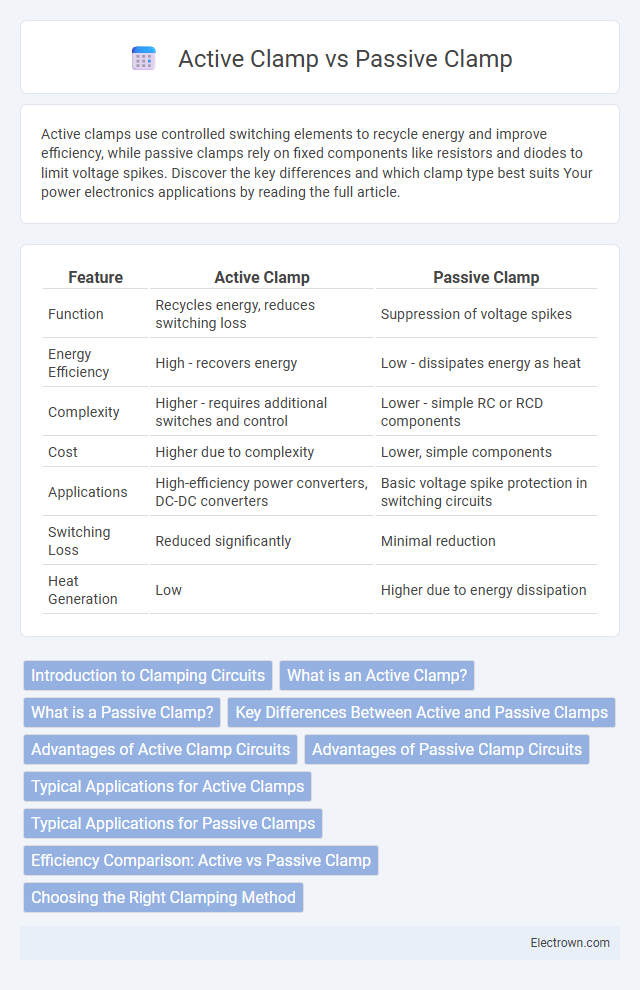Active clamps use controlled switching elements to recycle energy and improve efficiency, while passive clamps rely on fixed components like resistors and diodes to limit voltage spikes. Discover the key differences and which clamp type best suits Your power electronics applications by reading the full article.
Table of Comparison
| Feature | Active Clamp | Passive Clamp |
|---|---|---|
| Function | Recycles energy, reduces switching loss | Suppression of voltage spikes |
| Energy Efficiency | High - recovers energy | Low - dissipates energy as heat |
| Complexity | Higher - requires additional switches and control | Lower - simple RC or RCD components |
| Cost | Higher due to complexity | Lower, simple components |
| Applications | High-efficiency power converters, DC-DC converters | Basic voltage spike protection in switching circuits |
| Switching Loss | Reduced significantly | Minimal reduction |
| Heat Generation | Low | Higher due to energy dissipation |
Introduction to Clamping Circuits
Clamping circuits are essential in power electronics to limit voltage spikes and protect components from transient overvoltages. Active clamp circuits use controlled switches and capacitors to recycle energy and improve efficiency, while passive clamp circuits rely on diodes and resistors to dissipate excess energy, often resulting in higher power loss. Understanding the differences in energy recovery and dissipation mechanisms between active and passive clamps is crucial for optimizing circuit performance and reliability in applications like DC-DC converters and motor drives.
What is an Active Clamp?
An active clamp is an electrical circuit technique used to improve power converter efficiency by recycling energy stored in the leakage inductance of transformers or inductors during switching transitions. This method captures and redirects the energy back into the system, reducing voltage stress on semiconductor devices and minimizing power loss. Your power electronics design benefits from enhanced reliability and reduced electromagnetic interference when using active clamp circuits instead of traditional passive clamps.
What is a Passive Clamp?
A passive clamp is a circuit element used to limit voltage spikes and transients without the need for external power or active control components. It typically consists of diodes, resistors, and capacitors that absorb or redirect excess energy to protect sensitive electronics in power supply or switching applications. Understanding how a passive clamp functions can help you design more reliable protection circuits with minimal complexity and cost.
Key Differences Between Active and Passive Clamps
Active clamps use controlled switches and energy storage components like inductors or capacitors to recycle energy efficiently, reducing switching losses and improving overall performance in power converters. Passive clamps rely on fixed components such as resistors, diodes, or RC snubbers to dissipate energy as heat, resulting in simpler designs but lower efficiency and potential thermal stress. Your choice between active and passive clamps affects system reliability, efficiency, and thermal management in high-frequency switching applications.
Advantages of Active Clamp Circuits
Active clamp circuits offer improved energy recovery by recycling leakage inductance energy, which enhances overall efficiency compared to passive clamp circuits. They provide better voltage stress reduction on switching devices, resulting in increased reliability and longer component lifespan. Active clamps also enable higher switching frequencies and reduced electromagnetic interference (EMI), making them suitable for compact, high-performance power electronics.
Advantages of Passive Clamp Circuits
Passive clamp circuits offer the advantage of simplicity and cost-effectiveness, utilizing basic components like resistors and capacitors to limit voltage spikes and protect switching devices. They provide inherent reliability with fewer components, reducing the risk of failure and eliminating the need for external power sources or control signals. These circuits are particularly efficient in low-frequency applications where minimal power loss and straightforward implementation are key priorities.
Typical Applications for Active Clamps
Active clamps are commonly used in high-frequency power supplies, such as DC-DC converters and resonant converters, where efficient energy recovery and reduced switching losses are critical. They provide precise control over voltage spikes during transistor switching, making them ideal for applications demanding high efficiency and reliability, including server power systems and advanced battery chargers. Your choice of an active clamp circuit enhances system performance in load regulation and thermal management compared to passive clamps.
Typical Applications for Passive Clamps
Passive clamps are commonly deployed in low-cost, low-power switching power supplies, where simplicity and reliability are paramount. They are often found in flyback converters and DC-DC converters used in consumer electronics and LED drivers, providing effective voltage spike suppression without complex control circuitry. Their inherent energy dissipation method makes them suitable for applications where efficiency is less critical than cost and ease of implementation.
Efficiency Comparison: Active vs Passive Clamp
Active clamp circuits generally offer higher efficiency compared to passive clamps by actively recycling energy stored in the leakage inductance, reducing power dissipation during switching events. Passive clamps, relying on simple resistor-diode configurations, dissipate energy as heat, leading to lower overall efficiency in power conversion applications. Efficiency gains from active clamps are especially notable at higher switching frequencies and power levels, where energy recovery minimizes losses and improves thermal performance.
Choosing the Right Clamping Method
Choosing the right clamping method depends on your circuit's efficiency and complexity requirements; active clamps provide better energy recovery and reduce voltage stress on components, making them ideal for high-performance power supplies. Passive clamps, while simpler and cost-effective, rely on resistors and diodes to dissipate energy, often resulting in higher power loss and heat generation. Evaluating your design's power rating, switching frequency, and thermal management will help determine whether an active or passive clamp best suits your application.
Active clamp vs passive clamp Infographic

 electrown.com
electrown.com